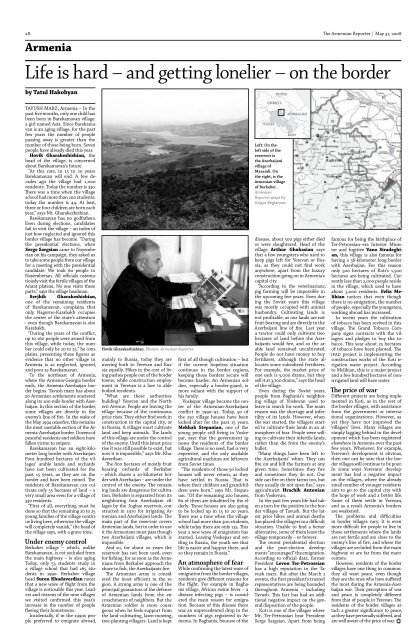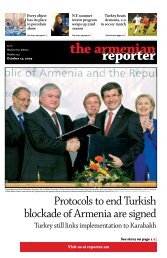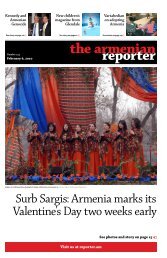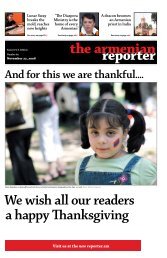You also want an ePaper? Increase the reach of your titles
YUMPU automatically turns print PDFs into web optimized ePapers that Google loves.
18 The <strong>Armenian</strong> <strong>Reporter</strong> | May 31, 2008ArmeniaLife is hard – and getting lonelier – on the borderby Tatul HakobyanTavush Marz, Armenia – In thepast five months, only one child hasbeen born in Barekamavan village:a girl named Asia. Since Barekamavanis an aging village, for the pastfew years the number of peoplepassing away is greater than thenumber of those being born. Sevenpeople have already died this year.Hovik Gharakeshishian, thehead of the village, is concernedabout Barekamavan’s future.“At this rate, in 15 to 20 yearsBarekamavan will end. A few decadesago the village had 1,000residents. Today the number is 330.There was a time when the villageschool had more than 200 students;today the number is 44. At best,three or four children are born eachyear,” says Mr. Gharakeshishian.Barekamavan has no godfathers.Even during elections, candidatesfail to visit the village – an index ofjust how neglected and ignored thisborder village has become. “Duringthe presidential elections, whenSerge Sargsian came to Noyemberianon his campaign, they asked usto take some people from our villagefor a meeting with the presidentialcandidate. We took 60 people toNoyemberian. All officials ostentatiouslyvisit the fertile villages of theArarat plateau. No one visits theseparts,” says the village headman.Serjhik Gharakeshishian,one of the remaining residentsof Barekamavan, complains thatonly Nagorno-Karabakh occupiesthe center of the state’s attention– even though Barekamavan is alsoKarabakh.“During the years of the conflict,up to 160 people were armed fromthis village, while today, the numbercould only be 20 to 25,” he complains,presenting these figures asevidence that no other village inArmenia is as neglected, ignored,and poor as Barekamavan.To the northeast of Armenia,where the Armenia-Georgia borderends, the Armenia-Azerbaijan borderbegins. Tavush marz has about20 <strong>Armenian</strong> settlements scatteredalong its 100-mile border with Azerbaijan.In this section of the border,some villages are directly in theenemy’s line of fire. In the wake ofthe May 1994 ceasefire, this remainsthe most unstable section of the Armenia-Azerbaijanborder. Dozens ofpeaceful residents and soldiers havefallen victim to snipers.Barekamavan has an eight-kilometerlong border with Azerbaijan.Four hundred hectares of the villages’arable lands and orchardshave not been cultivated for thepast 15 years, as they are on theborder and have been mined. Theresidents of Barekamavan can cultivateonly 55 hectares of land – avery small area even for a village of330 residents.“First of all, everything must bedone so that the remaining 20 to 25young families of the village continueliving here, otherwise the villagewill completely vanish,” the head ofthe village says, with a grave tone.Under enemy controlBerkaber village – which, unlikeBarekamavan, is not secluded fromthe main highway – is also aging.Today, only 53 students study ina village school that had 165 studentsin 1990. Berkaber villagehead Suren Khudaverdian notesthat a new wave of flight from thevillage is noticeable this year. Leadersand citizens of the nine villageswe visited confirmed this year’sincrease in the number of peoplefleeing their hometowns.Incidentally, if in the 1990s peoplepreferred to emigrate abroad,Hovik Gharakeshishian. Photos: <strong>Armenian</strong> <strong>Reporter</strong>.mainly to Russia, today they aremoving both to Yerevan and Russiaequally. Hikes in the cost of livingpushes people out of the bordertowns, while construction employmentin Yerevan is a lure to ablebodiedresidents.“What are these authoritiesbuilding? Yerevan and the NorthernAvenue. People are leaving thevillage because of the continuousprice rises. They either find work inconstruction in the capital city, orin Russia. A villager must cultivateland and keep animals. The landsof this village are under the controlof the enemy. Until this latest pricerise it was still possible to exist, butnow it is impossible,” says Mr. Khudaverdian.The 800 hectares of mostly fruitbearing orchards of Berkaber– which shares a 10-kilometer borderwith Azerbaijan – are under thecontrol of the enemy. The remaininglands are dangerous for cultivation.Berkaber is separated from itsneighboring four Azerbaijani villagesby the Joghaz reservoir, constructedin 1970 for irrigating <strong>Armenian</strong>and Azerbaijani lands. Themain part of the reservoir covers<strong>Armenian</strong> lands, but in order to useit the <strong>Armenian</strong>s must pass thoughtwo Azerbaijani villages, which isimpossible.And so, for about 20 years thereservoir has not been used, evenfor fishing; for as soon as the <strong>Armenian</strong>sfrom Berkaber approach theshore to fish, the Azerbaijanis fire.The <strong>Armenian</strong> army is consideredthe most efficient in the region.A strong army is one of theprincipal guarantors of the defenseof <strong>Armenian</strong> lands from the encroachmentsof neighbors. But the<strong>Armenian</strong> soldier is more courageouswhen he feels support fromthe land-cultivating, lawn-mowing,tree-planting villagers. Land is keptfirst of all though cultivation – butif the current hopeless situationcontinues in the border regions,keeping those borders secure willbecome harder. An <strong>Armenian</strong> soldier,especially a border-guard, ismore valiant with the support ofhis family.Voskepar village became the centerof the <strong>Armenian</strong>-Azerbaijaniconflict in 1990–91. Today, 50 ofthe 250 village houses have beenlocked shut for the past 15 years.Mekhak Stepanian, one of theyoung people still living in Voskepar,says that the government ignoresthe residents of the bordervillage. There is no seed, fuel is veryexpensive, and the only availableagricultural machines are leftoversfrom Soviet times.“The residents of those 50 lockedhouses will never return, as theyhave settled in Russia. That iswhere their children and grandchildrenwere born,” says Mr. Stepanian.“Of the remaining 200 houses,80 of them are inhabited by the elderly.Those houses are also goingto be locked up in 15 to 20 years.There was a time when the villageschool had more than 300 students,while today there are only 135. Thisyear a new wave of emigration hasstarted. Leaving Voskepar and settlingin Russia, the youth see thatlife is easier and happier there, andso they remain in Russia.”An atmosphere of fearWhile confirming the latest wave ofemigration from the border villages,residents give different reasons forthe flight. For example in Baghanisvillage, African swine fever – adisease infecting pigs – is consideredthe main reason for emigration.Because of this disease therewas an unprecedented drop in thenumbers of pigs registered in Armenia.In Baghanis, because of theLeft: On theleft side of thereservoir isthe Azerbaijanivillage ofMazamli. Onthe right, is the<strong>Armenian</strong> villageof Berkaber.<strong>Armenian</strong><strong>Reporter</strong> maps byGrigor Beglaryan.disease, about 500 pigs either diedor were slaughtered. Head of thevillage Arthur Ghukasian saysthat a few youngsters who used tokeep pigs left for Yerevan or Russia,as they could not find workanywhere, apart from the luxuryconstruction going on in Armenia’scapital city.“According to the veterinarians,pig farming will be impossible inthe upcoming five years. Even duringthe Soviet years this villagewas mostly occupied with animalhusbandry. Cultivating lands isnot profitable, as our lands are notfruit-bearing and are directly in theAzerbaijani line of fire. Last yeara tractor could only cultivate twohectares of land before the Azerbaijaniswould fire, and so the arableland remained uncultivated.People do not have money to buyfertilizers, although the state allocatessome subsidized fertilizers.For example, the market price ofone sack is 5,000 drams, but theysell it at 3,700 drams,” says the headof the village.Even during the Soviet years,people from Baghanis’s neighboringvillage of Voskevan used toleave in search for work. The mainreason was the shortage and infertilityof its lands. However, whenthe war started, the villagers startedto cultivate their lands in an atmosphereof fear. People were willingto cultivate their infertile lands,rather than die from the enemy’sbullet.“Many things have been left tothe Azerbaijanis’ whim. They canfire on and kill the farmers at anygiven time. Sometimes they fireand sometimes they do not. Ourside can fire on their farms too, butthey usually do not open fire,” saysagriculturist Hrachik Antonianfrom Voskevan.In the past few years life had takena turn for the positive in the bordervillages of Tavush. But the latestprice hikes and animal deathshas placed the villagers in a difficultsituation. Unable to find a betteralternative, some of them leave thevillage temporarily – or forever.The recent presidential electionand the post-election developments“encouraged” the emigration.According to official data, formerPresident Levon Ter-Petrossianhas a high reputation in the Tavushmarz. But after the March 1events, the first president’s trustedrepresentatives are being houndedthroughout Armenia – includingTavush. This fact has had an additionalnegative impact on the generaldisposition of the people.Koti is one of the villages whereMr. Ter-Petrossian beat PresidentSerge Sargsian. Apart from beingfamous for being the birthplace ofTer-Petrossian–era Interior Ministerand fugitive Vano Siradeghian,this village is also famous forhaving a 38-kilometer long borderwith Azerbaijan. For this reasononly 500 hectares of Koti’s 1,500hectares are being cultivated. Currentlyless than 2,000 people residein the village, which used to haveabout 3,000 residents. Felix Melikiannotices that even thoughthere is no emigration, the numberof people, especially the youngsters,working abroad has increased.In recent years the cultivationof tobacco has been revived in thisvillage. The Grand Tobacco Companysigns contracts with the villagersand pledges to buy the tobacco.This year about 25 hectaresof tobacco have been planted. TheIFAD project is implementing theconstruction works of the Koti irrigationwater project. Accordingto Melikian, this is a major projectand a few hundred hectares of nonirrigatedland will have water.The price of warDifferent projects are being implementedin Koti, as in the rest ofthe border villages, with assistancefrom the government or internationalorganizations. However, asyet they have not improved thevillagers’ lives. Many villages aresimply lagging behind in the developmentwhich has been registeredelsewhere in Armenia over the pastfew years. Whenever, for example,Yerevan’s development is obvious,then one can be sure that the bordervillages will continue to be poor.In some ways Yerevans’ developmenthas had a negative impacton the villages, where the alreadysmall number of younger residentsaim to go to the capital city withthe hope of work and a better life.Some of them settle in Yerevan,and as a result Armenia’s bordersare weakened.The problems and difficultiesin border villages vary. It is evenmore difficult for people to live inthose settlements where the landsare not fertile and are close to theenemy’s line of fire, and where thevillages are secluded from the mainhighway or are far from the marzcenters.However, residents of the bordervillages have one thing in common:they all want peace, even thoughthey are the ones who have sufferedthe most during the Armenia-Azerbaijanwar. Their perception of warand peace is completely differentfrom that of people in Yerevan. Theresidents of the border villages attacha greater significance to peace,as they have personally suffered, andare well aware of the price of war. f

















